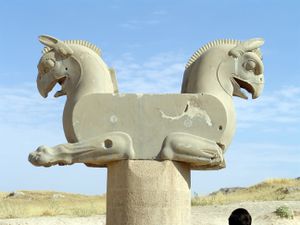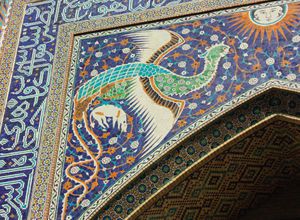フマ
フマはペルシア神話上の伝説の鳥。ペルシアのフェニックスと呼ばれることもあるが、実際には中国の吉兆の鳥、鳳凰と似ている部分が多い。例えば、雌雄を兼ね備えているところがある。だが、フマの場合は半分が雄で、もう半分が雌である。
フマはその影の落ちかかった者すべてに恩恵を与え、ほんのわずかな間でも、その頭に乗ることのできた幸運のものは、王になることが期待できる。
参考文献
- Wikipedia:フマ(最終閲覧日:22-03-21)

The Huma (テンプレート:Lang-fa, pronounced Homā, Avestan: Homāio), also Homa, is a mythical bird of Iranian legends and fables,[2][3] and continuing as a common motif in Sufi and Diwan poetry. Although there are many legends of the creature, common to all is that the bird is said never to alight on the ground, and instead to live its entire life flying invisibly high above the earth.
There are numerous folk interpretations of the name, among them that of the Sufi teacher Inayat Khan, who supposed that "in the word Huma, hu represents spirit, and the word mah originates from the Arabic 'Maʼa' テンプレート:Lang which means water."[4]
Myths and legends
The Huma bird is said to never come to rest, living its entire life flying invisibly high above the earth, and never alighting on the ground (in some legends it is said to have no legs).[5]
In several variations of the Huma myths, the bird is said to be phoenix-like, consuming itself in fire every few hundred years, only to rise anew from the ashes. The Huma bird is said to have both the male and female natures in one body (reminiscent of the Chinese Fenghuang), each nature having one wing and one leg. Huma is considered to be compassionate, and a 'bird of fortune'[6] since its shadow (or touch) is said to be auspicious.
In Sufi tradition, catching the Huma is beyond even the wildest imagination, but catching a glimpse of it or even a shadow of it is sure to make one happy for the rest of his/her life. It is also believed that Huma cannot be caught alive, and the person killing a Huma will die in forty days.[6]
In Ottoman poetry, the creature is often referred to as a 'bird of paradise';[6][7] early European descriptions of the Paradisaeidae species portrayed the birds as having no wings or legs, and the birds were assumed to stay aloft their entire lives.
In Attar of Nishapur's allegorical masterpiece The Conference of the Birds, an eminent example of Sufi works in Persian literature, the Huma bird is portrayed as a pupil that refuses to undertake a journey because such an undertaking would compromise the privilege of bestowing kingship on those whom it flew over. In Iranian literature, this kingship-bestowing function of the Huma bird is identified with pre-Islamic monarchs, and stands vis-a-vis ravens, which is a metaphor for Arabs.[8] The legend appears in non-Sufi art as well.[9]
The kingship-bestowing function of the Huma bird reappear in Indian stories of the Mughal era, in which the shadow (or the alighting) of the Huma bird on a person's head or shoulder were said to bestow (or foretell) kingship. Accordingly, the feathers decorating the turbans of kings were said to be plumage of the Huma bird.[10]
Sufi teacher Inayat Khan gives the bestowed-kingship legend a spiritual dimension: "Its true meaning is that when a person's thoughts so evolve that they break all limitation, then he becomes as a king. It is the limitation of language that it can only describe the Most High as something like a king."[4]
The Huma bird symbolizes unreachable highness in Turkish folk literature.[11] Some references to the creature also appear in Sindhi literature, where – as in the diwan tradition – the creature is portrayed as bringing great fortune. In the Zafarnama of Guru Gobind Singh, a letter addressed to Mughal Emperor Aurangzeb refers to the Huma bird as a "mighty and auspicious bird".
Legacy

- A British Museum catalog captions a photograph of the griffin-like capitals at Persepolis with "Column capital in the form of griffins (locally known as 'homa birds')".[1]
- The Persian language acronym for "Iran National Airline" is HOMA and the airline's emblem has a stylized rendering of a Huma bird.
- The Emblem of Uzbekistan represents the Huma bird.
- Herman Melville briefly alludes to the bird in Moby-Dick. At the beginning of the chapter entitled "The Tail", the narrator speaks of "the bird that never alights."
- It provides the title of Bird's Shadow, a collection of short stories by Ivan Bunin.
- It is also referred to in the movie Days of Being Wild by Wong Kar-wai and the play "Orpheus Descending" by Tennessee Williams.テンプレート:Citation needed
- The literature series Dragonlance named Krynn's greatest hero, Huma Dragonbane, after the Huma bird.
- the asteroid 3988 Huma discovered by Eleanor F. Helin named after the Huma bird. The asteroid's name was suggested by the SGAC Name An Asteroid Campaign[12]
See also
Further reading
参照
- ↑ 1.0 1.1 1.2 テンプレート:Citation
- ↑ テンプレート:Citation
- ↑ テンプレート:Citation
- ↑ 4.0 4.1 テンプレート:Citation.
- ↑ テンプレート:Citation.
- ↑ 6.0 6.1 6.2 テンプレート:Citation
- ↑ cf. テンプレート:Citation.
- ↑ テンプレート:Citation, p. 151.
- ↑ cf. テンプレート:Citation, p. 118.
- ↑ テンプレート:Citation.
- ↑ テンプレート:Citation
- ↑ 3988 Huma (1986 LA).{{{date}}} - via {{{via}}}.
